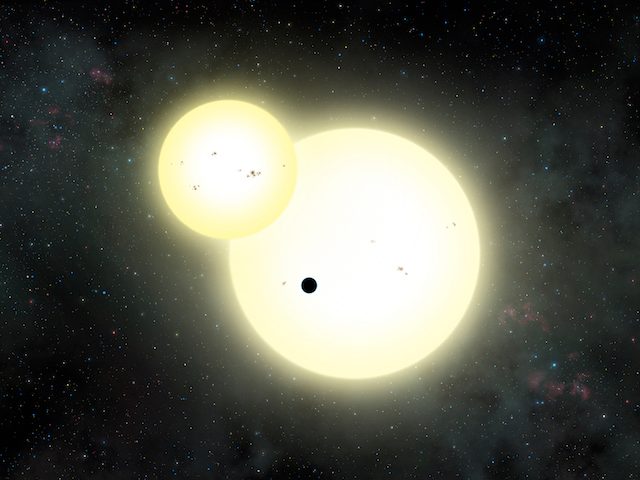SUMMARY
This is AI generated summarization, which may have errors. For context, always refer to the full article.

WASHNGTON DC, USA – Astronomers have discovered the largest planet outside our solar system orbiting two stars, at a distance that would make it potentially habitable for people, scientists announced Monday, June 13.
A team of NASA astronomers that made the discovery using the Kepler space telescope revealed the findings at a meeting of the American Astronomical Society in San Diego, California.
The gaseous planet – dubbed Kepler-1647 b – is the size of Jupiter and has a wide orbit, revolving around its two stars in 1,107 days, or around 3 Earth-years.
The discovery is the 11th of its kind since 2005.
Planets that orbit two stars – known as circumbinary planets – are sometimes called “Tatooines,” after the similar fictional planet in the movie Star Wars where Luke Skywalker was raised.
Kepler-1647 b is further from its two stars than any other known circumbinary planet, placing it in an orbit that “puts the planet within the so-called habitable zone,” a statement from San Diego State University (SDSU) said.
In theory, that would make the planet neither too hot nor too cold for human habitation, and water could exist in liquid form.
However, Kepler-1647 b is gaseous like Jupiter, making the possibility life could exist there unlikely.
Still, any large moons orbiting the planet could possibly host life.
At 4.4 billion years old, Kepler-1647 b is roughly the same age as the Earth. Its stars are also similar to the Sun, one slightly larger and the other slightly smaller, according to a research paper set to appear in The Astrophysical Journal.
Located near the Cygnus constellation, the planet lies some 3,700 light-years away from the Earth (a light-year is the equivalent of around 5.9 billion miles, or 9.5 billion kilometers).
Researchers are able to detect planets outside the solar system – called exoplanets – when they pass in front of their stars, causing “slight dips in brightness,” the researchers said.
“But finding circumbinary planets is much harder than finding planets around single stars,” co-author William Welsh, an SDSU astronomer, said. “The transits are not regularly spaced in time and they can vary in duration and even depth.”
Researchers who detect potential exoplanets use advanced computer software to verify the discoveries, a typically long and arduous process.
Astronomer Laurance Doyle of the SETI Institute – whose mission is to “search for extraterrestrial intelligence” – first noticed Kepler-1647 b’s transit in 2011.
Scientists required several years to collect and analyze additional data before they could confirm the planet’s discovery. – Rappler.com
Add a comment
How does this make you feel?
There are no comments yet. Add your comment to start the conversation.